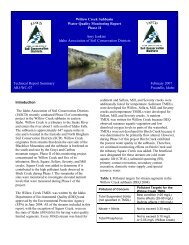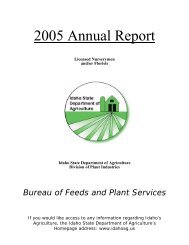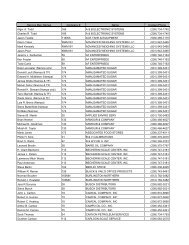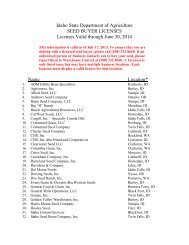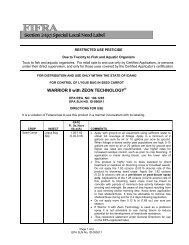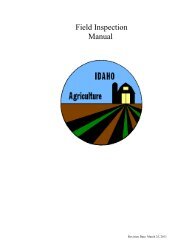2008 Statewide Strategic Plan for Eurasian Watermilfoil in Idaho
2008 Statewide Strategic Plan for Eurasian Watermilfoil in Idaho
2008 Statewide Strategic Plan for Eurasian Watermilfoil in Idaho
Create successful ePaper yourself
Turn your PDF publications into a flip-book with our unique Google optimized e-Paper software.
B. Description<br />
A number of milfoil species occur <strong>in</strong> the western United States, and many of these<br />
species are similar <strong>in</strong> appearance. <strong>Eurasian</strong> watermilfoil closely resembles its<br />
native relative northern milfoil (M. sibiricum), and was once thought to be a variety<br />
of that species.<br />
<strong>Eurasian</strong> watermilfoil is a rooted, perennial dicot that is submersed except <strong>for</strong> the<br />
upper flower-bear<strong>in</strong>g portions. The stem branches underwater and produces<br />
whorls of 4 (rarely 5) leaves around the stem at each node. The leaves have a<br />
grayish cast and feathery appearance. They are f<strong>in</strong>ely divided <strong>in</strong>to leaflets, each<br />
of which generally has 14 or more paired divisions. This feature can be used to<br />
dist<strong>in</strong>guish <strong>Eurasian</strong> watermilfoil from other milfoil species about 70 percent of the<br />
time. However, the number of pairs of leaflet divisions is variable and can range<br />
from 5 to 24,<br />
<strong>Eurasian</strong> watermilfoil is one of several aquatic <strong>in</strong>vasive weeds that reproduce<br />
primarily by fragmentation. Viable propagules can be as small as a stem portion<br />
carry<strong>in</strong>g a s<strong>in</strong>gle leaf node. Young plants and free-float<strong>in</strong>g plant fragments often<br />
develop leaflets with fewer than 14 divisions.<br />
In Figure 5, the leaflet on the left is <strong>Eurasian</strong><br />
watermilfoil; on the right is northern milfoil, M.<br />
sibiricum. Note the difference <strong>in</strong> leaflet shape,<br />
number of divisions, and spac<strong>in</strong>g of the divisions<br />
between the two species. Although the two<br />
species appear easy to dist<strong>in</strong>guish <strong>in</strong> this<br />
photograph, frequently these characteristics are<br />
not as dist<strong>in</strong>ctive.<br />
The grow<strong>in</strong>g stem tips of <strong>Eurasian</strong> watermilfoil<br />
(and other milfoil species) are tassel-like and often<br />
Figure 6. <strong>Eurasian</strong> watermilfoil <strong>in</strong><br />
flower<br />
Figure 5. <strong>Eurasian</strong> watermilfoil<br />
(left) and northern milfoil (right)<br />
red; especially early <strong>in</strong> the grow<strong>in</strong>g season. T<strong>in</strong>y<br />
p<strong>in</strong>kish flowers occur on reddish spikes that stand<br />
several <strong>in</strong>ches above the water and submerge<br />
when poll<strong>in</strong>ation is complete (Figure 6). The stem<br />
width of <strong>Eurasian</strong> watermilfoil almost doubles<br />
below the <strong>in</strong>florescence. Lower flowers are<br />
pistillate, upper flowers stam<strong>in</strong>ate. Seeds are<br />
produced, but seedl<strong>in</strong>gs are rare <strong>in</strong> the field. In<br />
situations where water evaporates slowly and the<br />
plants become stranded gradually, <strong>Eurasian</strong><br />
watermilfoil can develop <strong>in</strong>to a terrestrial <strong>for</strong>m. The<br />
leaves of the terrestrial <strong>for</strong>m are smaller, stiffer,<br />
and have fewer divisions. If these plants are<br />
submerged, new aquatic leaves develop <strong>in</strong> 7-10<br />
days, but the first leaves <strong>for</strong>med have relatively<br />
16



